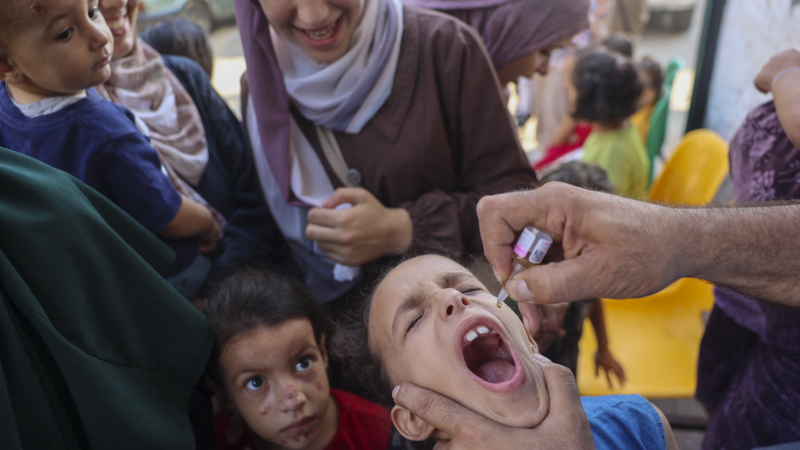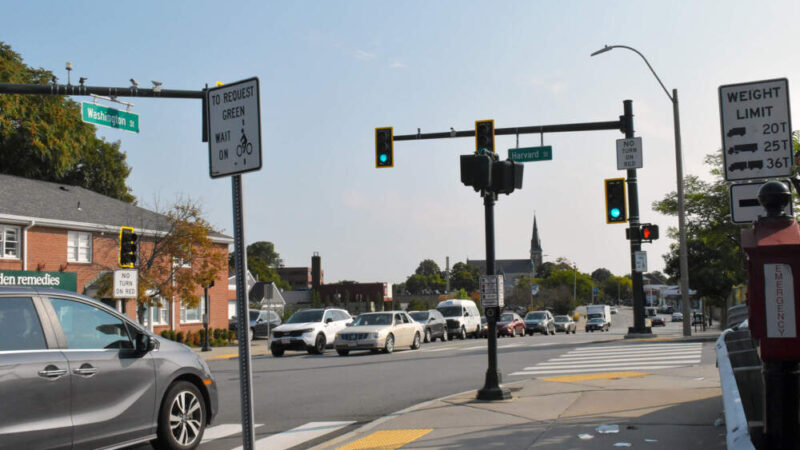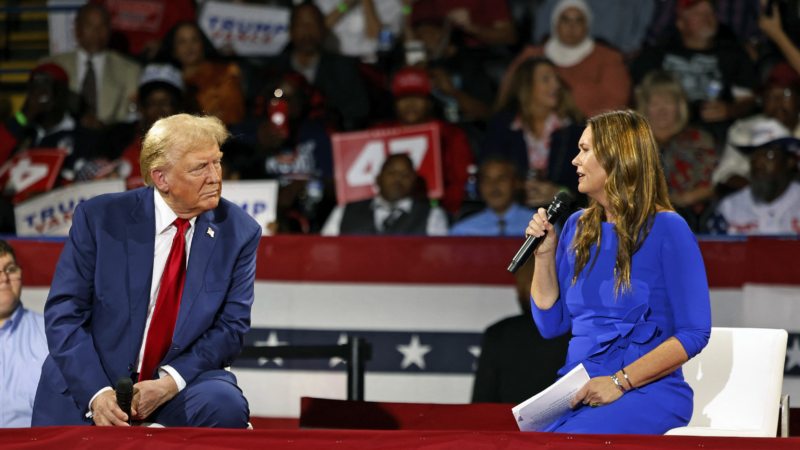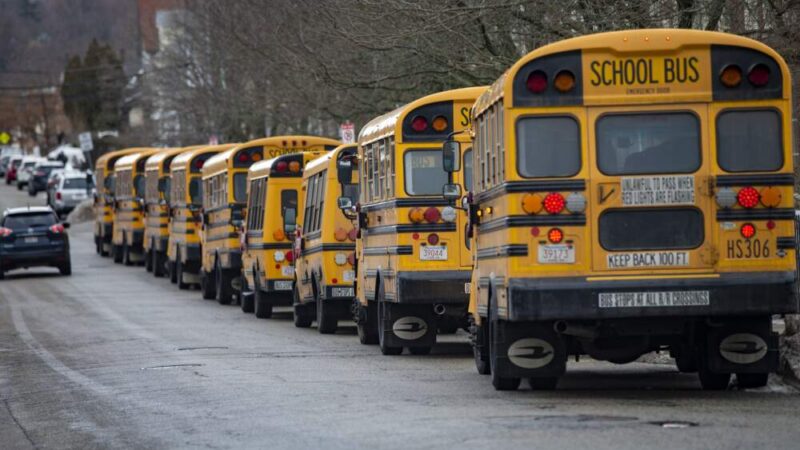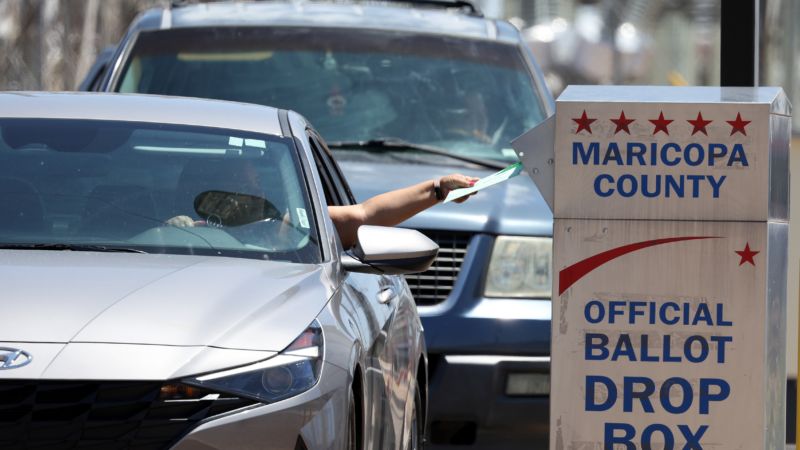The latest on where Gaza’s polio came from — and the race to contain it
The first wave of a massive vaccination campaign against polio is wrapping up in Gaza.
The World Health Organization (WHO) says that in less than two weeks, they’ve helped administer more than 550,000 polio vaccines to children across the enclave. But the work is only half done.
“We start the race against time for the second stage of the campaign,” says Juliette Touma with the U.N. Relief and Works Agency, the group that’s administering the vaccines. “We have to do all of this all over again to give the children the second doses of vaccines against polio.”
Polio is a highly infectious virus that can lead to paralysis and even death. It often spreads through fecal matter. This is a problem in Gaza, which has suffered destruction of much of its water treatment infrastructure.
“Solid waste everywhere,” says Dr. Majdi Duhair, a retired epidemiologist in Gaza. “No clean drinking water, no hygiene.”
This has all led to plenty of sewage in the streets — the perfect recipe for the spread of polio. So when the virus turned up in wastewater samples in the enclave, alarm bells went off, especially because vaccination programs in Gaza have collapsed since the war began.
Sure enough, last month, a little boy not quite one year old became paralyzed in both of his legs. He is Gaza’s first confirmed case of polio in a quarter century.
“Scientifically, one confirmed case of polio — it is considered as an outbreak,” says Duhair. That’s because a single case points to roughly 200 more people who are infected but not showing symptoms. No other cases have surfaced in Gaza so far, but “we are expecting the circulation of this virus is very high in the community,” he says.
Where Gaza’s polio came from
Health officials sequenced the polio virus that appeared in Gaza and traced it to a strain last seen in Egypt in 2023. “There are obviously interactions between people in Egypt and in Gaza,” says Raul Andino, an immunologist at the University of California, San Francisco. “And this virus is very infectious, very easy to transmit.”
Andino explains that the oral vaccine — which is comprised of a weakened form of the polio virus — is “extremely safe” to get and that it protects the recipient from polio. It’s also easy to administer, requiring just two drops in the mouth and no needles. Rarely, however, when that weakened virus is shed in a person’s stool, it can mutate and regain its ability to cause disease.
This is what happened with the strain now in Gaza. People were vaccinated orally in Egypt and at some point, the virus that they shed in their fecal matter became virulent again.
But here’s where the real problem lies: “When you reduce the regular vaccinations in a given population,” says Andino, “you end up having a number of individuals that are susceptible to be infected.”
This is the reason that public health officials moved quickly to launch a mass campaign of polio vaccination.
Vaccinating in a war zone
Duhair worked as the director of public health in Gaza’s Ministry of Health for three decades. Since he retired two years ago, he’s been asked for advice on various matters. Then, in mid-July, he got a call from the Ministry to head up the committee overseeing the planning and rollout of the vaccination effort.
“Without hesitation, I cannot refuse serving my population,” says Duhair. “I am a Palestinian, and they are our children. Immediately, I accept[ed] the job.”
Andino helped develop the novel oral polio vaccine that was used in the campaign. Unlike the previous version (used in Egypt among many other places worldwide) that only needed one mutation to recapture the capacity to cause disease, this new vaccine requires three. “That makes the virus safer,” Andino says. “It’s not perfect, but it’s safer.”
The goal of the vaccination effort was to reach at least 90% of the kids in Gaza under ten. (The risk for adults is much lower.) There was a lot to do in very little time.
Duhair and his colleagues coordinated with groups like UNICEF to deliver the vaccine to Gaza and WHO to bring in the refrigeration to keep the vaccine cool.
Right off the bat, the team faced challenges. Chief among them was running the campaign in the middle of a war zone. “It’s impossible to undertake a vaccination campaign of such volume and scale under a sky full of airstrikes,” says Touma. “Impossible.”
That’s why it was crucial that the Israeli army and Hamas agree to briefly pause the fighting in different areas specially for the immunization effort. These respites allowed the vaccination teams to disperse throughout the enclave.
They also had to figure out how to drive the vaccine and the vaccinators around Gaza, a little territory crammed full of people displaced from months of Israeli air strikes.
“It is a matter of overcrowding of a small area,” explains Duhair. “And of course, the streets are damaged.”
So Duhair and his team planned accordingly. They started early at 6 a.m every day. And they put extra vehicles on the roads in case any were delayed.
Usually, a campaign like this would move house to house to vaccinate as many children as possible. But in Gaza, they couldn’t since there are so few houses left and people are often moving hour by hour.
“That presented an immense level of challenge in terms of mapping the population and also correctly estimating the population sizes in each location,” WHO’s Deepak Kumar said at a press briefing.
He says more than 200 teams have been involved with the vaccination effort, tracking the numbers of children in Gaza and how many have been vaccinated. “The data was watched over very closely until we were confident that we have reached more than 95% of coverage,” says Kumar.
“We go from shelter to shelter and tent to tent,” says Touma. “People are literally everywhere. I mean, in the middle of the street, you have people living by the beach. So the idea is to reach every child wherever they are.”
Success amid a bigger struggle
WHO reports that families were enthusiastic about having their children vaccinated.
“We are happy with this polio campaign,” says Dr. Richard Peeperkorn, WHO Representative for the West Bank and Gaza. “And I think we are also quite confident that we reached an enormous amount of children in this short time.”
It was a considerable undertaking. “I don’t think a polio campaign has ever been done like this globally, constrained by time and security as we’re currently undergoing in Gaza,” says Scott Anderson, deputy humanitarian coordinator with the U.N.
Anderson is stationed in Gaza, and he likens the vaccination effort to putting a band aid on a much deeper wound — a territory whose people and infrastructure have been bombarded for over 11 months by Israeli air strikes after the war that started after the Hamas-led attack on southern Israel on October 7.
“We’re really just hoping and praying that there’s not a larger outbreak of disease,” he says.
Vaccination is just a piece of the polio response. For the next six months, officials will need to be vigilant to ensure there’s no virus circulating in either the people or the wastewater of Gaza. That’s when they’ll know if the outbreak is over.
Still, this territory is but one place in the world where the virus is present. These spots have things in common, like insecurity, poor hygiene and reduced access to health care and routine vaccination programs.
Zubair Wawood is an epidemiologist and polio expert with WHO, one of several groups that comprise the Global Polio Eradication Initiative.
“There’s a 99.9% reduction in the number of polio cases since the start of this initiative more than three decades back,” says Wawood, “and we are at the very, very last mile of this.”
And yet, Wawood says that upheavals like the one in Gaza and elsewhere in the world — involving war, displacement, chronic disruption — make that last mile a lot longer.
Transcript:
ARI SHAPIRO, HOST:
The first wave of a massive polio vaccination campaign is wrapping up in Gaza. The World Health Organization says, in less than two weeks, they’ve helped administer more than 550,000 polio vaccines to children across the enclave. But the work is, at best, half done. Health officials must soon give kids a second dose. Science reporter Ari Daniel has more.
ARI DANIEL: Dr. Majdi Duhair is an epidemiologist from Gaza who worked for the territory’s Ministry of Health for 30 years. Today, when he looks around this place he calls home, he sees wreckage and devastation.
MAJDI DUHAIR: No clean water – drinking water, no hygiene.
DANIEL: Which has led to plenty of sewage in the streets. This is the perfect recipe for the transmission of diseases, including polio, a highly infectious virus that can spread through fecal matter. So when polio turned up in wastewater samples in the enclave, alarm bells went off, especially because vaccination programs in Gaza have collapsed since the war began. Sure enough, last month, a little boy, not quite 1 year old, became paralyzed in both of his legs. He’s Gaza’s first case of polio in a quarter century.
DUHAIR: On confirmed case of polio – it is considered as an outbreak.
DANIEL: An outbreak because a single case points to roughly 200 more people who are infected but not showing symptoms. No other cases have surfaced in Gaza so far, but…
DUHAIR: We are expecting the circulation of this virus is very high (ph).
DANIEL: So public health officials moved quickly to launch a massive campaign of oral polio vaccination. The goal – to reach at least 90% of the kids in Gaza under 10. The big challenge was how to do it in the middle of a war zone. Juliette Touma is with the U.N. Relief and Works Agency, the group that’s doing the actual vaccinating.
JULIETTE TOUMA: It’s impossible to undertake a vaccination campaign of such volume and scale under a sky full of airstrikes. Impossible.
DANIEL: That’s why it was crucial that the Israeli army and Hamas agree to briefly pause the fighting in different areas. Usually, a campaign like this would go house to house to vaccinate as many kids as possible. But in Gaza, they couldn’t, since there are so few houses left, and people are often moving hour by hour.
TOUMA: We go from shelter to shelter and tent to tent. People are literally everywhere. I mean, in the middle of the street. You have people living by the beach. So the idea is to reach every child wherever they are.
DANIEL: The World Health Organization says that families were enthusiastic about having their children vaccinated. Richard Peeperkorn is with the global health body.
RICHARD PEEPERKORN: We are happy with this polio campaign. And I think we are also quite confident that we reached an enormous amount of children in this short time.
DANIEL: In the coming weeks, the whole undertaking will happen again as the teams try to track down the same more than half a million children and give them their second dose of the vaccine.
SCOTT ANDERSON: I don’t think a polio campaign has ever been done like this globally, constrained by time and security as we’re currently undergoing in Gaza.
DANIEL: Scott Anderson is deputy humanitarian coordinator with the U.N. He’s stationed in Gaza, and he likens this vaccination effort to putting a band aid on a much deeper wound, a territory whose people and infrastructure have been bombarded for over 11 months.
ANDERSON: We’re really just hoping and praying that there’s not a larger outbreak of disease.
DANIEL: Vaccination is just a piece of the polio response. For the next six months, officials will need to be vigilant to ensure there’s no virus circulating in neither the people nor the wastewater of Gaza. And that’s when they’ll know if the outbreak is over. For NPR News, I’m Ari Daniel.
(SOUNDBITE OF MUSIC)
Newton faith leaders on how to ease turmoil in city after pro-Israel demonstration turned violent
Members of the Newton Interfaith Leadership Association met Tuesday to discuss how to respond to heightened tensions after last week's shooting at a small pro-Israel demonstration.
Trump held his first campaign event since the apparent assassination attempt
Trump’s town hall in Michigan was shorter than his typical campaign rally, but he used the event to discuss everything from the failed attempts on his life to a promise to boost the auto industry.
Hiccups from new bus tracker app and late student registrations behind bus delays, Boston leaders say
Mayor Michelle Wu says she's confident that the system will consistently improve once new student registrations slow down after a late summer surge and drivers work through new tracking technology glitches.
A records flaw could block thousands in Arizona from voting in state and local races
Arizona officials say the flaw could disqualify nearly 100,000 people from voting in non-federal races. At issue is proof of citizenship records required by the state to participate in such elections.
A man’s therapist challenged him to a race. He said it was a spark of life
On this week's "My Unsung Hero:" In 2014, Wil was being treated for major depression at an inpatient mental health program. One day, his therapist issued a challenge that renewed his sense of purpose.
The body transforms in remarkable ways during pregnancy. So does the brain
NPR's Ari Shapiro talks with Emily Jacobs of UC Santa Barbara about how pregnancy reshapes the brain, the subject of a study out this week in the journal Nature Neuroscience.
